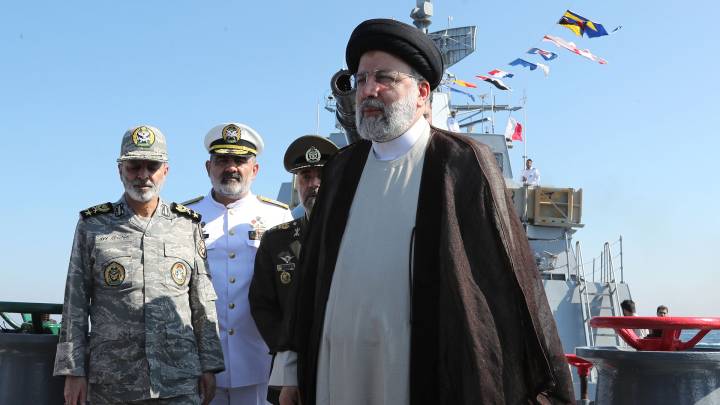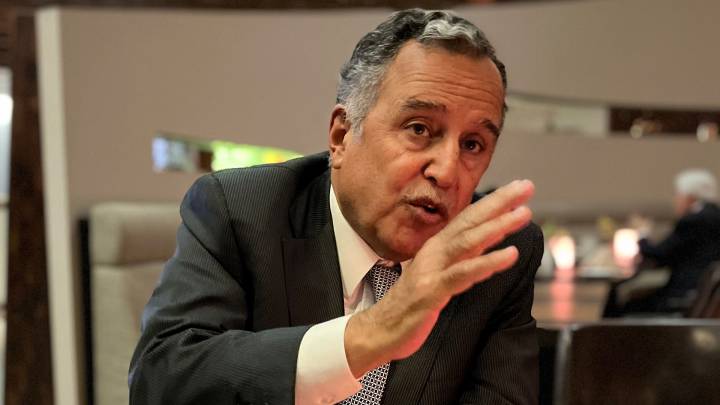Iran regards the escalation in Gaza as an expectable and even necessary event. From Tehran’s perspective, Hamas’s incursion into Israel has already done irreparable damage to Israeli self-esteem as it shattered the trust of the Israeli public in the country’s military and intelligence forces.
Iran officially congratulated Hamas on its military ‘success’ and the Gazans on their ‘steadfastness’. Beyond that, Iran’s president voiced his concerns regarding regional escalation and behind closed doors, Iranian diplomats berated Hamas leaders during a visit to Tehran for not having provided any information about their actions beforehand. That said, one wonders what role Palestine in general and Hamas in peculiar plays in Iran’s regional policy.
In its foreign policy and strategy, the Islamic Republic of Iran combines ideological and geographical approaches on the basis of a simple "4x3" formula, which applies four ideological principles to three regions. Perhaps reflecting realities, the Iranians rather opportunistically combine two revolutionary ideologies (i.e. against the status-quo) with two conservative ones (i.e. preserving the status-quo). The revolutionary ideologies are political Islam in the sense of Ayatollah Khomeini (Khomeinism), which intends to unite Shiites and Sunnis, but is essentially Shiite, and Third-Worldism, a remnant of the global Marxist Left of the 1970s, which is mainly directed at the Global South. The conservative ideologies are Iranian nationalism with a strong xenophobic bent and traditional clergy-centred Shiism.
Iran applies said principles to three regions: the immediate neighbourhood, the Middle East region and the Global South (so-called developing countries). Depending on circumstances and the history of bilateral relations, Iran may apply more than one ideological approach to a certain region or country. In such a case, the Iranians task different institutions with the implementation of their policy or policies.
Further strategic guidelines are laid down in the Iranian constitution, which stipulates neutrality in the sense of non-alignment and support for liberation movements all over the world as foreign policy and strategic maxims (Articles 152-154). In reality, however, Tehran tries to use ideological-revolutionary organisations abroad as elements to project power and to contain identified and suspected threats to the country. The inherent tension between ideological or revolutionary and pragmatic or conservative approaches was resolved in 1984 when the Iranians adapted the principle of expediency or expedient interests (maslahat-e nezam) to the effect that the survival of the regime and the prevention of an attack on Iran takes precedence over all other interests.
This also essentially applies to relations with Israel. The existence of the country is rejected in principle, but the Iranian revolutionaries cooperated with the “Zionist entity” during the Iran-Iraq War (1980-88), albeit clandestinely. Iran received sanctioned weapons and medical supplies from the Jewish state. At that time, Israel regarded Saddam Hussein’s Iraq, which boasted massive military resources and acted as a standard-bearer of Arab nationalism and state sponsor of the PLO, as a greater threat than the chaotic revolutionaries in Tehran. Israeli pragmatism ended quickly, however, when the Lebanese Hezbollah was found bearing Israeli weapons, sent them by Iran. The Lebanese Hezbollah organisation was one of the many militias set up by Iran in the early 1980s to serve as instruments in the export of revolution, and it has remained the most important.
Other such militias included Badr, made up of Shiite Iraqi volunteers during the Iran-Iraq war. Occasionally even Sunni groups took inspiration from the Islamic Revolution and created their own armed groups. The most important is the Gaza-based Palestinian Islamic Jihad (PIJ), founded in 1981, which remains the Palestinian group with closest relations to the Iranians. PIJ’s importance, however, was quickly outshone by an offshoot of the Palestinian branch of the Muslim Brotherhood: the Islamic Resistance Movement Hamas, founded in 1987 during the Palestinian uprising (intifadha) against the Israelis.
For Iran, Hamas gained importance only after the Iran-Iraq War, when Tehran tried to woo it into its “Axis of Resistance” (mehvar-e moqavemat). Said “axis” was to help reorganise Iran’s relations with politically and ideologically disparate actors on the basis of shared opposition against Israel and US interests in the region. With this realignment, Tehran managed to paper over the major internal differences between the secularist and Arab nationalist regime in Damascus, the Shiite revolutionary Hezbollah, the PIJ and later Hamas and gave this alliance of convenience an ideological meaning.
For Hamas, approaching Tehran was a convenient way of reasserting its political role in the region when Arab powers closed their doors to them. Externally directed against Israel, the Axis of Resistance was primarily an alliance against Saudi Arabia and its support for the Israeli-Palestinian peace process, which ignored the interests of Hamas and rejected Iran's involvement, which is why the Saudis spoke of a “Shiite crescent”, whose influence should be pushed back.
The slow collapse of the peace process in the late 1990s, the overthrow of the Taliban in Afghanistan in 2001, that of Saddam Hussein in Iraq in 2003, and Israel's war against Hezbollah in southern Lebanon in 2006 enabled Tehran to play a more active role in the region (inter alia because Tehran's allies, such as the Badr Brigade, took on important functions in the Iraqi security apparatus). Tehran interpreted the so-called Arab Spring of the 2010s as an ‘Islamic awakening’, which would end with the overthrow of all pro-Western and non-Islamic regimes. However, Tehran’s ally Syria also almost fell and Iran was forced, alongside Russia, to marshal all the forces they could field to keep Bashar Al Assad in power.
Said forces are comprised of Shiite militias from Iraq (united in the Abulfadhl Brigade), Afghanistan (Fatemiyun Brigade) and India and Pakistan (Zeynabiya Brigade) as well as regular army units (elements of the 65th Airborne Division), well trained reserve units from the Revolutionary Guards such as the Saberin and Fatehin units, a strong intelligence presence and of course Lebanese Hizbullah. Together with Russia, they managed to keep Assad in Damascus, but the decade-long conflict and the continuing war has been draining the strength of the internationally isolated regime. Tehran was only successful in the fight against the so-called Islamic State because its Iraqi allies cooperated with the USA and European states, which ultimately led to the liberation of Mosul in 2017.
Iran’s half-hearted support for the Houthis (Ansarollah) in Yemen turned out to be a serious mistake. Tehran has no special relations with Yemen, not even with the Shiite Houthis, whilst the situation in Yemen directly affects Saudi Arabia’s internal security and domestic affairs. Hence, the Iranians annoyed their powerful neighbor Saudi Arabia without having control over the actions and strategies of the Houthis, their alleged ally. It is still unclear what role Tehran played in the Yemeni rocket attacks of 2018 and 2019. Nevertheless, in the following year 2020, both sides realised that they were in a strategic stalemate. Tehran also suffered the humiliating killing of a prominent general by the United States and suffered a major loss of reputation among its own population when it accidentally shot down a Ukrainian airliner that same year.
Ebrahim Raisi, the new president, tried to improve relations with his Arab neighbours and with Afghanistan. Anti-Saudi propaganda was toned down, and the Iranians only cautiously criticised the normalisation of relations between Israel and the United Arab Emirates and later Saudi Arabia. In Afghanistan, relations with the arch enemy Taliban were normalised after they took power in Kabul following the surprise redeployment of the USA. Tehran noted with satisfaction that not a single Muslim state tried to exploit the situation during the 2022/23 unrest.
This also ended decades of disastrous policies in which Iran and Saudi Arabia did not shy away from stirring up unrest among each other’s confessional minorities. Following Chinese mediation, Tehran and Saudi Arabia decided to normalise their bilateral relations again in March 2023. This step was made easier by a Saudi change of course, which, for reasons unrelated to Iran, saw its interests better served by readmitting Syrian dictator Bashir Al Assad to the Arab fold. Iranian-Saudi relations have now developed positively without Saudi-Israeli relations suffering.
Hamas’s attack of 7 October 2023 surprised Iran as much as it did everybody else. Since then, Tehran has been trying to prevent the conflict from spreading. It finds itself in the same boat with Saudi Arabia and the UAE, because in Tehran, concern regarding a possible uncontrollable escalation outweighs gloating about Israel's problems. Thus, Tehran inter alia ensures that the skirmishes between the Lebanese Hezbollah and Israel do not get out of control.
In the medium term, it can be assumed that the Iranians will refocus their policies on the economy. This requires good relations with the neighbouring states UAE and Saudi Arabia, which are particularly strong in the financial sector. At the same time, it has also become clear to Tehran that the Syrian war and the recent escalation in Gaza have made the concept of the Axis of Resistance no longer suitable as a framework for strategic action. It is therefore to be expected that Tehran will (have to) rely on a de-escalation with Riyadh in other areas as well.
This article originally appeared in Italian on Limes - Rivista italiana di geopolitica n. 11-2023 (Le intelligenze dell'intelligence), with the title "Anche l'Iran prova a contenere la guerra".




